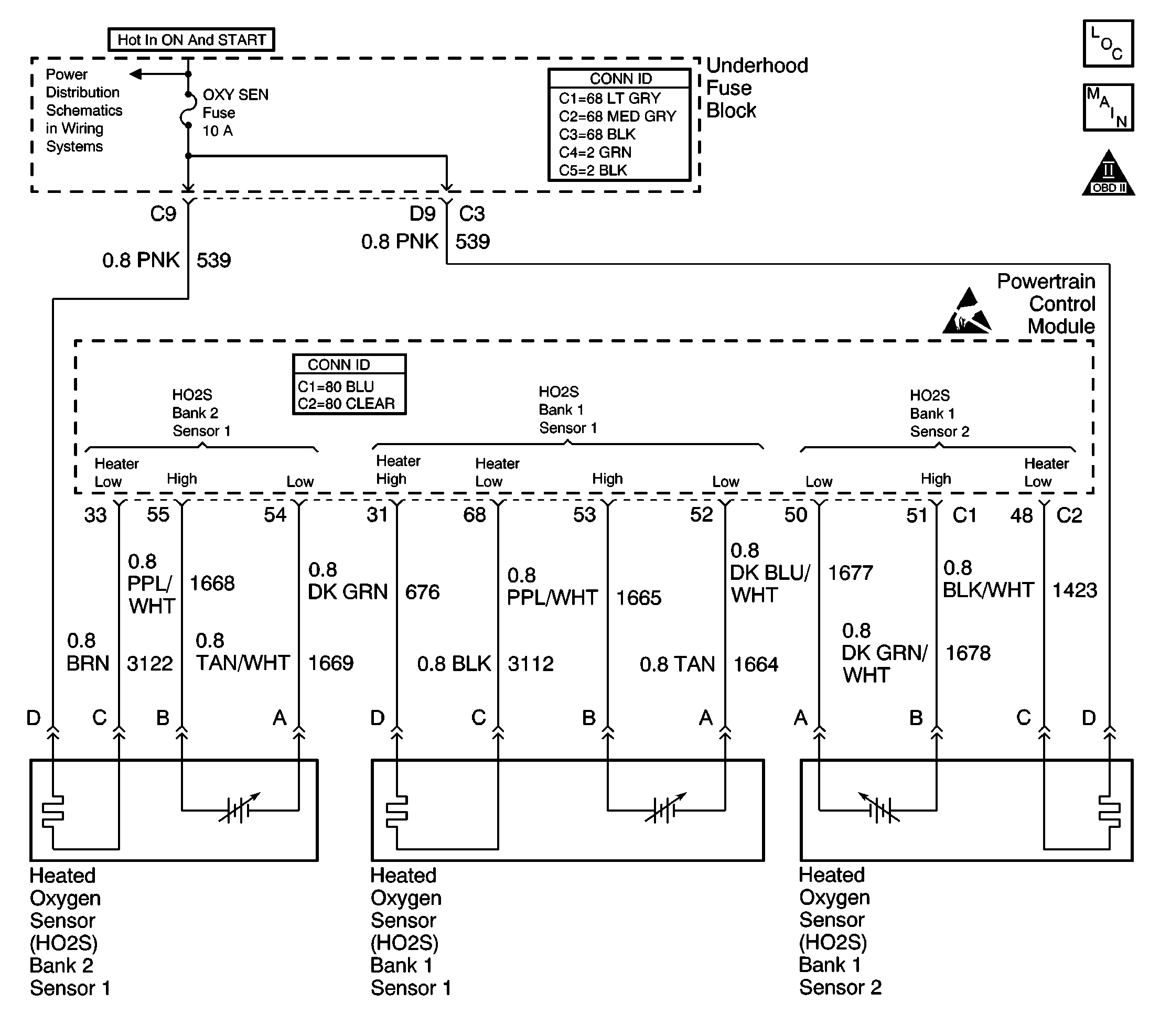
Circuit Description
The HO2S is a sensor used to detect oxygen-content in the exhaust. The PCM supplies the sensor with a signal circuit and a ground circuit. The PCM supplies a bias voltage between the circuits. The sensor varies the voltage based on the oxygen content in the exhaust. When the exhaust stream is lean (more oxygen), the sensor produces a low voltage signal. When the exhaust stream is rich (less oxygen), the sensor produces a high voltage signal.
The PCM monitors the HO2S sensor activity to determine a time ratio for the lean to rich and rich to lean switches. A lean to rich switch occurs when the HO2S signal voltage changes from less than 300 mV to more than 600 mV. A rich to lean switch occurs when the HO2S signal voltage switches from more than 600 mV to less than 300 mV. The PCM counts the number of lean to rich and rich to lean switches for 100 seconds. The PCM records the amount of time required to complete all transitions. With this information, the PCM determines an average transition time for the lean to rich switches, and the rich to lean switches. By dividing the rich to lean time by the lean to rich time, the PCM determines an average transition time ratio. If the PCM detects an average transition time ratio for HO2S bank 2 sensor 1 that is out of range, DTC P1154 will set.
| • | TP sensor, MAF sensor, MAP sensor, IAT sensor, ECT sensor, EVAP system, EVAP control, AIR system, AIR control, fuel injector, fuel trim, EGR Flow, or system voltage DTCs are not set. |
| • | The engine speed is between 1500-3000 RPM. |
| • | The MAF is between 15-35 gps. |
| • | The canister purge duty cycle is more than 20 percent. |
| • | The TP angle is more than 5 percent. |
| • | The system voltage is between 8-18 volts. |
| • | The coolant temperature is above 50°C (122°F). |
| • | The closed loop fuel control is enabled. |
| • | The air fuel ratio is between 14.5-14.8. |
Conditions for Setting the DTC
The ratio of average transition times is not 3 and 0.7.
Action Taken When the DTC Sets
| • | The PCM illuminates the malfunction indicator lamp (MIL) during the second consecutive trip in which the diagnostic test runs and fails. |
| • | The PCM stores the conditions present when the DTC set as Freeze Frame/Failure Records data. |
Conditions for Clearing the MIL/DTC
| • | The PCM will turn the MIL OFF after the third consecutive trip in which the diagnostic runs and passes. |
| • | The history DTC will clear after 40 consecutive warm-up cycles have occurred without a malfunction. |
| • | The DTC can be cleared by using the scan tool Clear DTC Information function. |
Diagnostic Aids
Notice: Do not solder heated oxygen sensor wires. Soldering the wires will result in the loss of the air reference to the sensor. Refer to Engine Electrical for proper wire and connection repair techniques.
If the condition is intermittent, refer to Intermittent Conditions .
Test Description
The numbers below refer to the step numbers on the diagnostic table.
-
Testing if other possible causes of this DTC have already been diagnosed.
-
Diagnose other DTCs first because they may be the cause of this DTC setting.
-
With the engine running warm, coolant at least 85°C (185°F) and at fast idle, the oxygen sensor voltage should rapidly swing above 0.60 volt and below 0.30 volt.
-
Testing if the oxygen sensor voltage is swinging between rich and lean very slowly, or not at all.
-
Testing for causes of oxygen sensor failure. If the sensor is replaced without finding the cause of contamination, premature failure of the new sensor may result.
Step | Action | Values | Yes | No | ||||||
|---|---|---|---|---|---|---|---|---|---|---|
1 | Did you perform the Powertrain On-Board Diagnostic (OBD) System Check? | -- | ||||||||
Were you sent here from another DTC? | -- | |||||||||
Are any other DTCs set? | -- | |||||||||
Does the HO2S voltage rapidly swing above and below the range specified? | 325-625 mV | |||||||||
5 | With engine running at 2000 RPM, observe the scan tool display Loop Status. Does the display indicate Closed? | -- | Go to Diagnostic Aids | |||||||
Does the HO2S voltage remain between the specified values longer than it swings outside this range? | 325-625 mV | |||||||||
7 |
Did you find and correct the condition? | -- | ||||||||
8 |
Did you find and correct the condition? | -- | ||||||||
|
Important: Before replacing the oxygen sensor, the cause of contamination must be found and corrected. Test for the following items:
Replace HO2S. Refer to Heated Oxygen Sensor Replacement - Bank 2 . Is the action complete? | -- | -- | ||||||||
10 |
Does the scan tool indicate that DTC P1154 passed? | -- | System OK |
